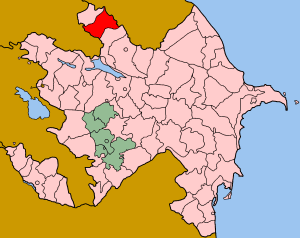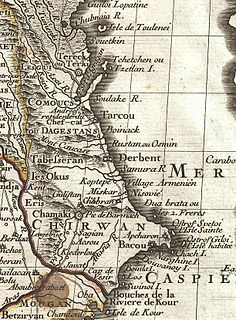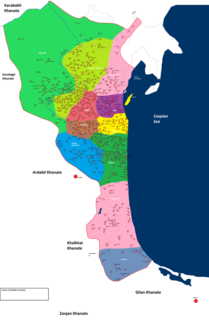 W
WThe Afsharid dynasty was an Iranian dynasty that originated from the Turkoman Afshar tribe in Iran's north-eastern province of Khorasan, ruling Iran (Persia) in the mid-eighteenth century. The dynasty was founded in 1736 by the brilliant military commander Nader Shah, who deposed the last member of the Safavid dynasty and proclaimed himself as the Shah of Iran.
 W
WBaku Khanate, was an autonomous Muslim principality under Iranian suzerainty, which existed between 1747 and 1806. Originally a province of Safavid empire, it became practically independent after the assassination of Nadir shah and weakening of central authority in Iran due to the struggle for power. Its territory now lies within present-day Azerbaijan,
 W
WThe Derbent Khanate was a Caucasian khanate that was established in Afsharid Iran. It corresponded to southern Dagestan and its center was at Derbent. It included the northern clans of Lezgian people.
 W
WThe Djaro-Belokani communities were a group of self-governing communities in the Caucasus from the 17th to the 19th centuries. They had close ties with the Elisu Sultanate to the southeast.
 W
WThe Sultanate of Elisu, also known as Elisou or Ilisu, was one of the Khanates of the Caucasus in the 18th and 19th centuries.
 W
WGanja Gate is one of four entrance gates to Shusha fortress in Shusha city of Azerbaijan. The fortress and the city was under the occupation of the self-proclaimed Republic of Artsakh since the capture of Shusha on May 8, 1992 until 8 November 2020 when Azerbaijan Army recaptured the city after a 3-day long battle.
 W
WThe Ganja Khanate was a semi-independent Caucasian khanate that was established in Afsharid Iran and existed in the territory of what is modern-day Azerbaijan between 1747-1805. The principality was ruled by the dynasty of Ziyadoglu (Ziyadkhanov) of Qajar extraction as governors under the Safavids and Nadir Shah. Shahverdi Solṭan Ziyad-oglu Qajar became the khan of Ganja in 1554.
 W
WHasan Khan Shahseven was the ruler of Javad Khanate under the suzerainty of the Afsharid dynasty.
 W
WIbrahim Khalil Khan palace or Ibrahim Khalil Khan castle is a historical palace located in the south-eastern part of Shusha, near Dashalty village. In some sources, the palace is also called palace of Karabakh Khans.
 W
WJavad Khanate was a khanate in the territory of modern Azerbaijan with its capital in the town of Javad. It extended from Javad on the Kura River southwest along the east side of the Aras River. It was bordered by Shamakhy Khanate (north), Karabakh Khanate (west), Karadagh khanate (southwest), Talysh Khanate (south), and Salyan Sultanate (east).
 W
WKazakh sultanate or Gazakh sultanate was established at the end of the XV century. During the Safavid Empire, it was part of the Karabakh principality. In 1605, by the decree of Abbas the Great, Shamsaddin sultan of Kazakh was given the rank of Khan.
 W
WPanah-Ali Khan Javanshir was the founder and first ruler of the Karabakh Khanate under Persian suzerainty.
 W
WThe khanates of the Caucasus, or Azerbaijani khanates or Persian khanates, or Iranian khanates,were various provinces and principalities established by Persia (Iran) on their territories in the Caucasus from the late Safavid to the Qajar dynasty. The Khanates were mostly ruled by Khans of Azerbaijani origin and were vassals and subjects of the Iranian shah (King). Persia permanently lost a part of these khanates to Russia as a result of the Russo-Persian Wars in the course of the 19th century, while the others were absorbed into Persia.
 W
WThe Kingdom of Kartli-Kakheti (1762–1801) was created in 1762 by the unification of two eastern Georgian kingdoms of Kartli and Kakheti. From the early 16th century, according to the 1555 Peace of Amasya, these two kingdoms were under Iranian control. In 1744, Nader Shah granted the kingship of Kartli to Teimuraz II and that of Kakheti to his son Heraclius II, as a reward for their loyalty. When Nader Shah died in 1747, Teimuraz II and Heraclius II capitalized on the instability in Iran proper, and declared de facto independence. After Teimuraz II died in 1762, Heraclius succeeded him as ruler of Kartli, thus unifying the two.
 W
WQutqashen Sultanate also known as Qabala mahaly was feudal state which existed from the middle to the end of 18th century in the north of Azerbaijan, in the territories covering the present day Qabala Rayon.
 W
WThe Russo-Persian War of 1722–1723, known in Russian historiography as the Persian campaign of Peter the Great, was a war between the Russian Empire and Safavid Iran, triggered by the tsar's attempt to expand Russian influence in the Caspian and Caucasus regions and to prevent its rival, the Ottoman Empire, from territorial gains in the region at the expense of declining Safavid Iran.
 W
WThe Shirvan province was a velayat (province) founded by the Safavid Empire on the territory of modern Azerbaijan and Russia (Dagestan) between 1501 and 1736 with its capital in the town of Shamakhi.
 W
WShaki khanate was one of the most powerful Caucasian khanates established in Afsharid Iran, on the northern territories of modern Azerbaijan, between 1743 and 1819 with its capital in the town of Shaki.
 W
WShamshadil, Shamshaddil, or The Sultanate of Shamshaddil was a sultanate established in 1747. Its area was 4,200 versts, and the population mainly consisted of Zulgadar clan, taking roots from the Qizilbash Turkic tribes. The sultanate was located near Lake Sevan and covered the territories of the modern day Tavush Province in Armenia and some parts of Tovuz District in Azerbaijan, with the center in the village of Oksuzlu, in the territory of Tovuz.
 W
WShirvan Khanate was a khanate founded by the Afsharid dynasty that existed in what is now Azerbaijan in 1748—1820.
 W
WShusha fortress is a fortress surrounding the historical centre of Shusha. Newly established castle town was called "Panahabad fortress" named after Panah Ali Khan who was the founder of the fort. In later years, the city was just called "Fortress". After a certain period of time, people named it as "Shusha fortress" and later it was simply called "Shusha". The name of Shusha was probably derived from the name of Shushekend village which was near the location where the fort was built.
 W
WSumug-gala is a defence castle in the Bucag neighborhood of İlisu village of Gakh region. It was built in the 17th-18th century.
 W
WThe region of Talish was a region of the Safavid Iran (1501–1736), loacated in the greater Talish, present-day divided between Iran and Azerbaijan countries. The territory of the region was principally made up of the two subordinate governorates of "Astara" and "Lankaran". The city of Astara was its administrative center, the base of Safavid power in the region.
 W
WTalysh Khanate or Talish Khanate was a khanate of Iranian origin that was established in Persia and existed from the middle of the 18th century till the beginning of the 19th century, located in the south-west coast of the Caspian Sea.
 W
WThe Zand dynasty was an Iranian dynasty, founded by Karim Khan Zand that initially ruled southern and central Iran in the 18th century. It later quickly came to expand to include much of the rest of contemporary Iran, as well as Azerbaijan, Bahrain, and parts of Iraq and Armenia.